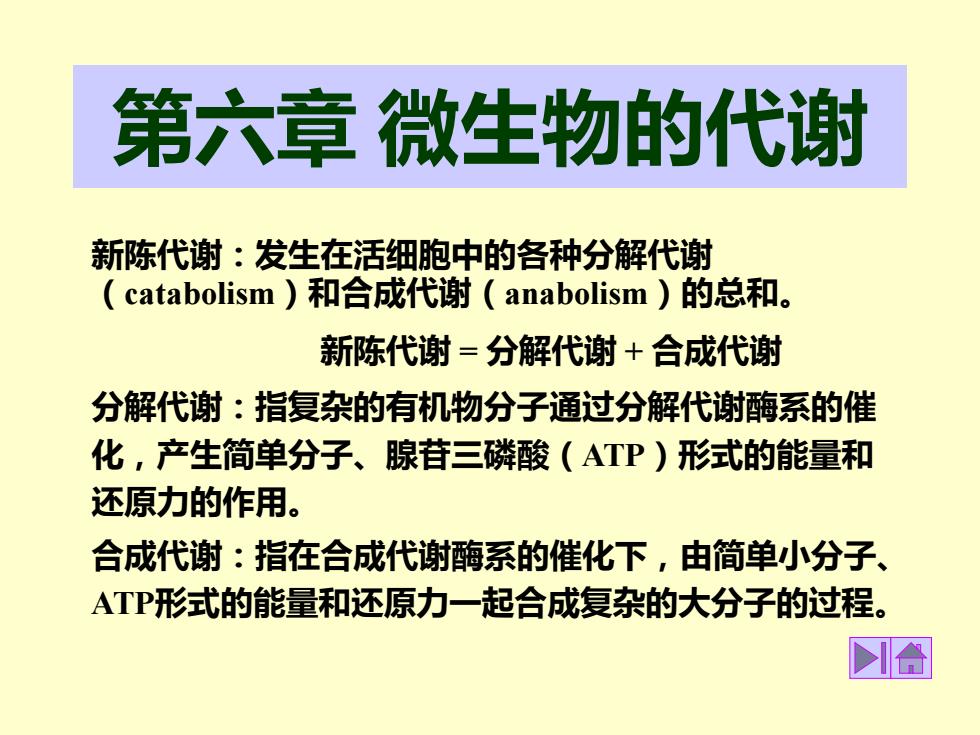
第六章 微生物的代谢 新陈代谢:发生在活细胞中的各种分解代谢 (catabolism)和合成代谢(anabolism)的总和。 新陈代谢 = 分解代谢 + 合成代谢 分解代谢:指复杂的有机物分子通过分解代谢酶系的催 化,产生简单分子、腺苷三磷酸(ATP)形式的能量和 还原力的作用。 合成代谢:指在合成代谢酶系的催化下,由简单小分子、 ATP形式的能量和还原力一起合成复杂的大分子的过程
第六章 微生物的代谢 新陈代谢:发生在活细胞中的各种分解代谢 (catabolism)和合成代谢(anabolism)的总和。 新陈代谢 = 分解代谢 + 合成代谢 分解代谢:指复杂的有机物分子通过分解代谢酶系的催 化,产生简单分子、腺苷三磷酸(ATP)形式的能量和 还原力的作用。 合成代谢:指在合成代谢酶系的催化下,由简单小分子、 ATP形式的能量和还原力一起合成复杂的大分子的过程
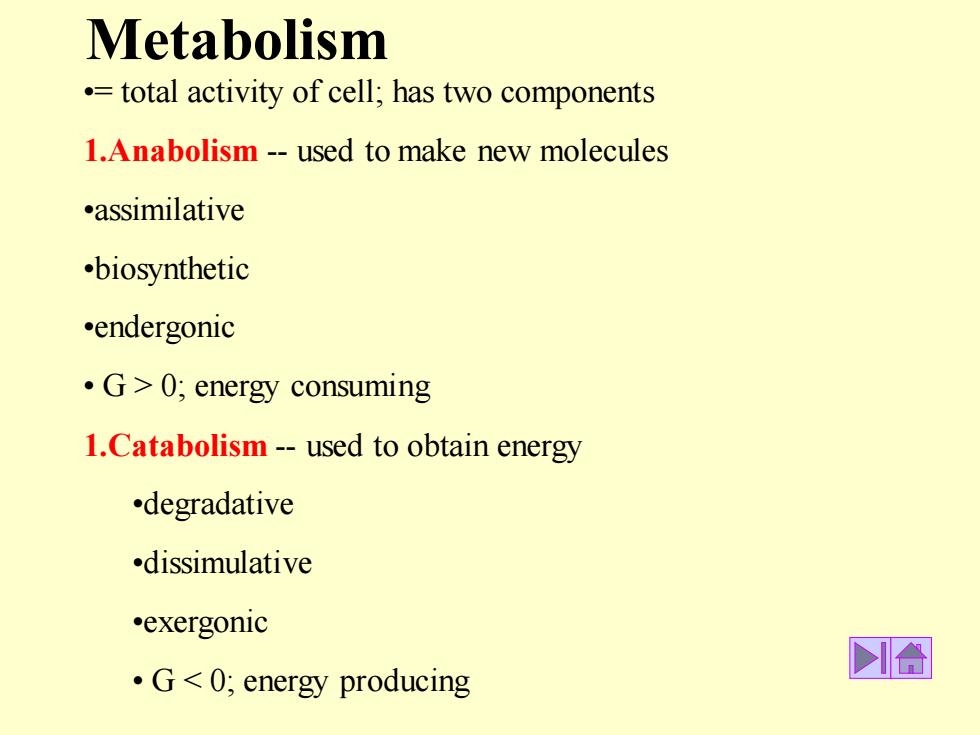
•= total activity of cell; has two components 1.Anabolism - used to make new molecules •assimilative •biosynthetic •endergonic • G > 0; energy consuming 1.Catabolism - used to obtain energy •degradative •dissimulative •exergonic • G < 0; energy producing Metabolism
•= total activity of cell; has two components 1.Anabolism - used to make new molecules •assimilative •biosynthetic •endergonic • G > 0; energy consuming 1.Catabolism - used to obtain energy •degradative •dissimulative •exergonic • G < 0; energy producing Metabolism
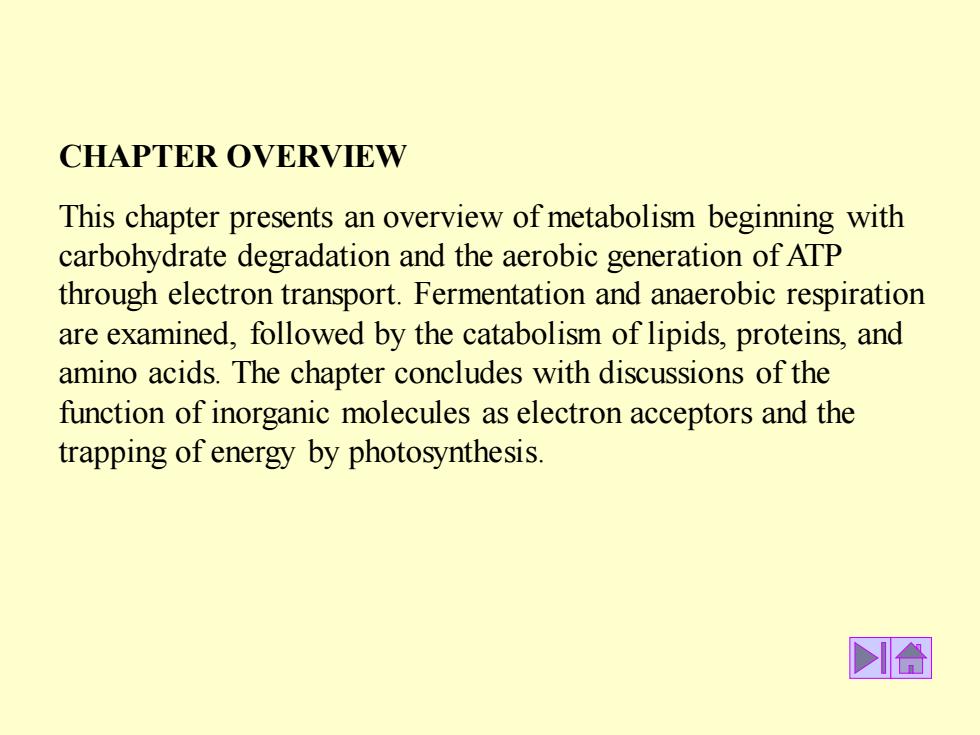
CHAPTER OVERVIEW This chapter presents an overview of metabolism beginning with carbohydrate degradation and the aerobic generation of ATP through electron transport. Fermentation and anaerobic respiration are examined, followed by the catabolism of lipids, proteins, and amino acids. The chapter concludes with discussions of the function of inorganic molecules as electron acceptors and the trapping of energy by photosynthesis
CHAPTER OVERVIEW This chapter presents an overview of metabolism beginning with carbohydrate degradation and the aerobic generation of ATP through electron transport. Fermentation and anaerobic respiration are examined, followed by the catabolism of lipids, proteins, and amino acids. The chapter concludes with discussions of the function of inorganic molecules as electron acceptors and the trapping of energy by photosynthesis

第一节 代谢概论 一、代谢是生命的基本特征: 二、代谢通过代谢途径完成: 三、代谢途径是不平衡的稳态体系■ 四、代谢途径的形式多样 五、代谢途径有明确的细胞定位 六、代谢途径相互沟通 七、代谢途径间有能量关联 八、关键酶限制代谢途径的流量
第一节 代谢概论 一、代谢是生命的基本特征: 二、代谢通过代谢途径完成: 三、代谢途径是不平衡的稳态体系■ 四、代谢途径的形式多样 五、代谢途径有明确的细胞定位 六、代谢途径相互沟通 七、代谢途径间有能量关联 八、关键酶限制代谢途径的流量

Figure 1. The relationship between catabolism and anabolism in a cell
Figure 1. The relationship between catabolism and anabolism in a cell
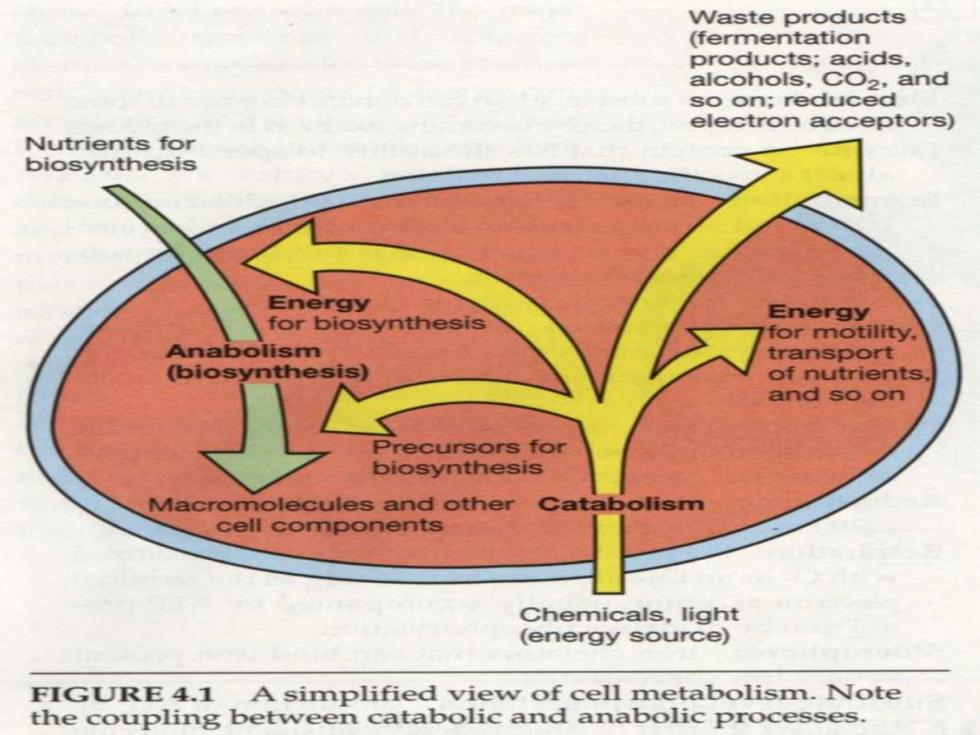
Waste products (fermentation products;acids, alcohols,CO2,and so on;reduced electron acceptors) Nutrients for biosynthesis Energy for biosynthesis Energy for motility. Anabolism transport (biosynthesis)】 of nutrients and so on Precursors for biosynthesis Macromolecules and other Catabolism cell components Chemicals,light (energy source) FIGURE 4.1 A simplified view of cell metabolism.Note the coupling between catabolic and anabolic processes
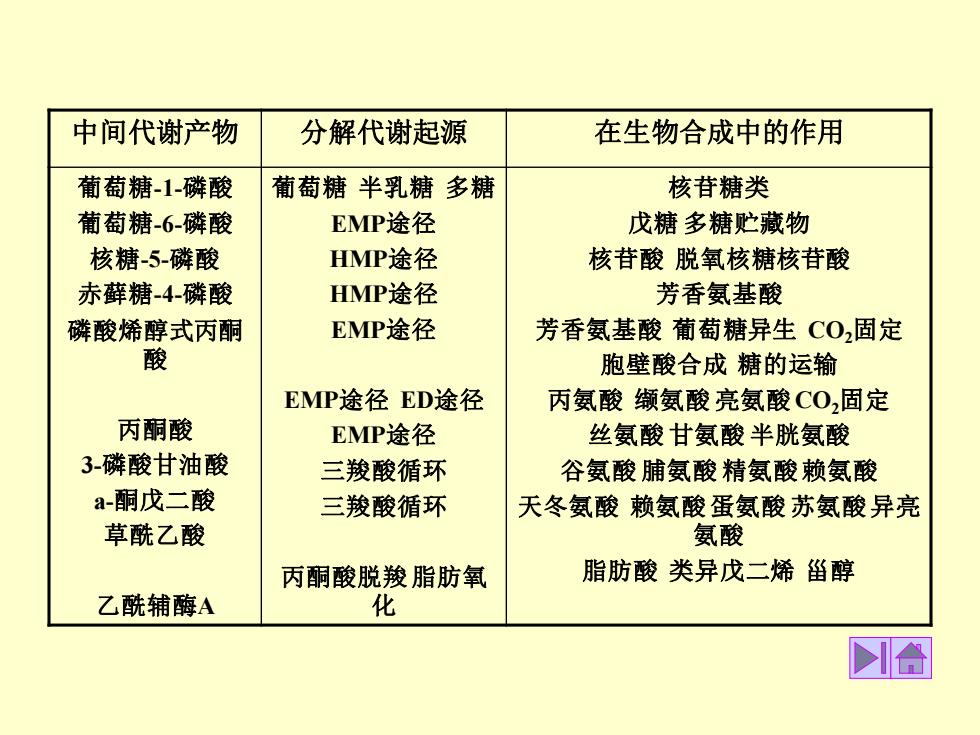
中间代谢产物 分解代谢起源 在生物合成中的作用 葡萄糖-1-磷酸 葡萄糖-6-磷酸 核糖-5-磷酸 赤藓糖-4-磷酸 磷酸烯醇式丙酮 酸 丙酮酸 3-磷酸甘油酸 a-酮戊二酸 草酰乙酸 乙酰辅酶A 葡萄糖 半乳糖 多糖 EMP途径 HMP途径 HMP途径 EMP途径 EMP途径 ED途径 EMP途径 三羧酸循环 三羧酸循环 丙酮酸脱羧脂肪氧 化 核苷糖类 戊糖 多糖贮藏物 核苷酸 脱氧核糖核苷酸 芳香氨基酸 芳香氨基酸 葡萄糖异生 CO2固定 胞壁酸合成 糖的运输 丙氨酸 缬氨酸 亮氨酸 CO2固定 丝氨酸 甘氨酸 半胱氨酸 谷氨酸 脯氨酸 精氨酸赖氨酸 天冬氨酸 赖氨酸蛋氨酸 苏氨酸异亮 氨酸 脂肪酸 类异戊二烯 甾醇
中间代谢产物 分解代谢起源 在生物合成中的作用 葡萄糖-1-磷酸 葡萄糖-6-磷酸 核糖-5-磷酸 赤藓糖-4-磷酸 磷酸烯醇式丙酮 酸 丙酮酸 3-磷酸甘油酸 a-酮戊二酸 草酰乙酸 乙酰辅酶A 葡萄糖 半乳糖 多糖 EMP途径 HMP途径 HMP途径 EMP途径 EMP途径 ED途径 EMP途径 三羧酸循环 三羧酸循环 丙酮酸脱羧脂肪氧 化 核苷糖类 戊糖 多糖贮藏物 核苷酸 脱氧核糖核苷酸 芳香氨基酸 芳香氨基酸 葡萄糖异生 CO2固定 胞壁酸合成 糖的运输 丙氨酸 缬氨酸 亮氨酸 CO2固定 丝氨酸 甘氨酸 半胱氨酸 谷氨酸 脯氨酸 精氨酸赖氨酸 天冬氨酸 赖氨酸蛋氨酸 苏氨酸异亮 氨酸 脂肪酸 类异戊二烯 甾醇

物质代谢:物质在体内转化的过程. •能量代谢:伴随物质转化而发生的能量形式相互转化. 按代谢产物在机体中作用不同分: •初级代谢: 提供能量、前体、结构物质等生命活动所 必须的代谢物的代谢类型;产物:氨基酸、核苷酸等. •次级代谢: 在一定生长阶段出现非生命活动所必需的代谢类型; 产物:抗生素、色素、激素、生物碱等 按物质转化方式分: 分解代谢:指细胞将大分子物质降解成小分子物质,并在 这个过程中产生能量。 合成代谢:是指细胞利用简单的小分子物质合成复杂大分 子的过程。在这个过程中要消耗能量
物质代谢:物质在体内转化的过程. •能量代谢:伴随物质转化而发生的能量形式相互转化. 按代谢产物在机体中作用不同分: •初级代谢: 提供能量、前体、结构物质等生命活动所 必须的代谢物的代谢类型;产物:氨基酸、核苷酸等. •次级代谢: 在一定生长阶段出现非生命活动所必需的代谢类型; 产物:抗生素、色素、激素、生物碱等 按物质转化方式分: 分解代谢:指细胞将大分子物质降解成小分子物质,并在 这个过程中产生能量。 合成代谢:是指细胞利用简单的小分子物质合成复杂大分 子的过程。在这个过程中要消耗能量
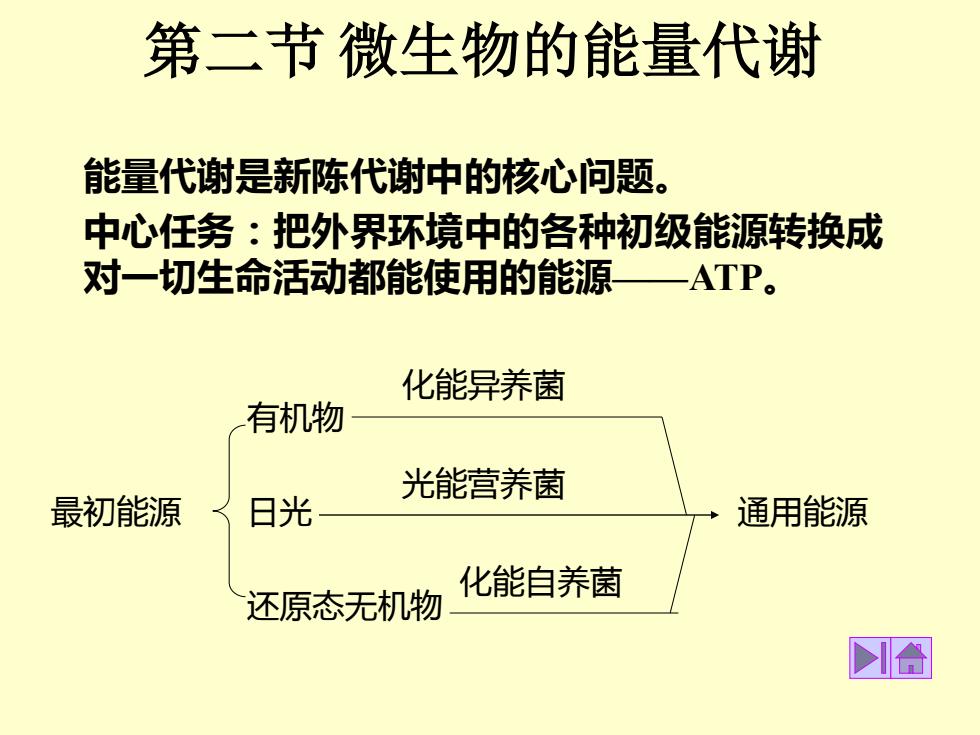
第二节 微生物的能量代谢 能量代谢是新陈代谢中的核心问题。 中心任务:把外界环境中的各种初级能源转换成 对一切生命活动都能使用的能源——ATP。 有机物 最初能源 日光 通用能源 还原态无机物 化能自养菌 化能异养菌 光能营养菌
第二节 微生物的能量代谢 能量代谢是新陈代谢中的核心问题。 中心任务:把外界环境中的各种初级能源转换成 对一切生命活动都能使用的能源——ATP。 有机物 最初能源 日光 通用能源 还原态无机物 化能自养菌 化能异养菌 光能营养菌
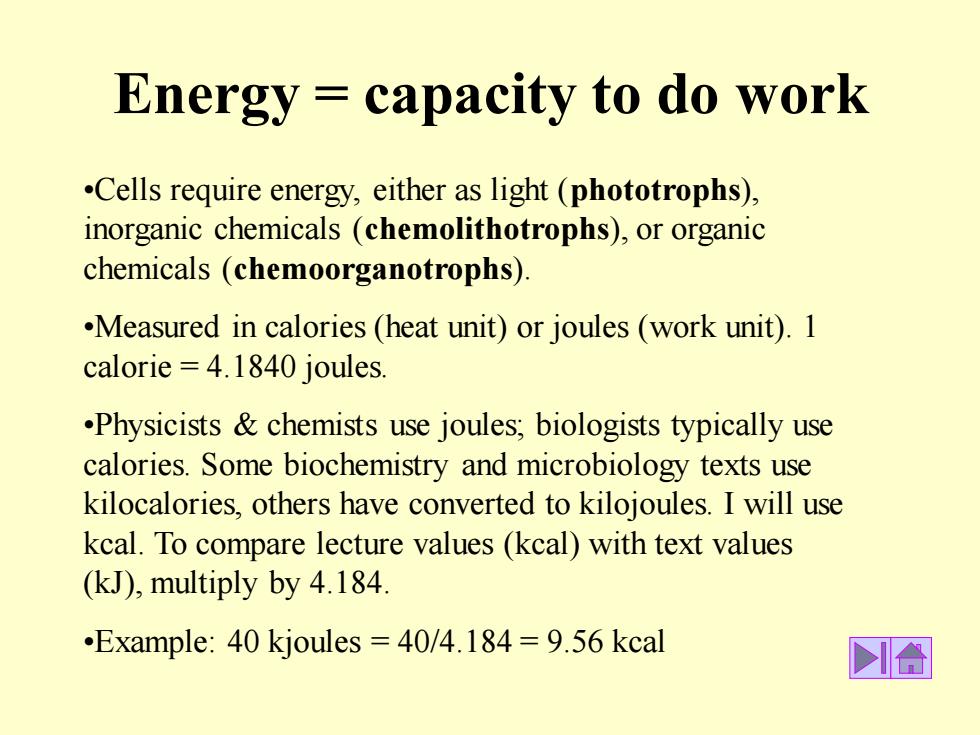
•Cells require energy, either as light (phototrophs), inorganic chemicals (chemolithotrophs), or organic chemicals (chemoorganotrophs). •Measured in calories (heat unit) or joules (work unit). 1 calorie = 4.1840 joules. •Physicists & chemists use joules; biologists typically use calories. Some biochemistry and microbiology texts use kilocalories, others have converted to kilojoules. I will use kcal. To compare lecture values (kcal) with text values (kJ), multiply by 4.184. •Example: 40 kjoules = 40/4.184 = 9.56 kcal Energy = capacity to do work
•Cells require energy, either as light (phototrophs), inorganic chemicals (chemolithotrophs), or organic chemicals (chemoorganotrophs). •Measured in calories (heat unit) or joules (work unit). 1 calorie = 4.1840 joules. •Physicists & chemists use joules; biologists typically use calories. Some biochemistry and microbiology texts use kilocalories, others have converted to kilojoules. I will use kcal. To compare lecture values (kcal) with text values (kJ), multiply by 4.184. •Example: 40 kjoules = 40/4.184 = 9.56 kcal Energy = capacity to do work